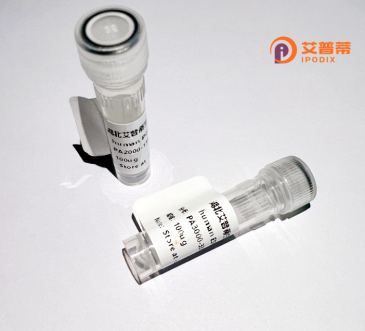
| 纯度 | >90%SDS-PAGE. |
| 种属 | Human |
| 靶点 | PTPRJ |
| Uniprot No | Q12913 |
| 内毒素 | < 0.01EU/μg |
| 表达宿主 | E.coli |
| 表达区间 | 38-137 aa |
| 活性数据 | GTPSPIPDPSVATVATGENGITQISSTAESFHKQNGTGTPQVETNTSEDGESSGANDSLRTPEQGSNGTDGASQKTPSSTGPSPVFDIKAVSISPTNVIL |
| 分子量 | 36.74 kDa |
| 蛋白标签 | GST-tag at N-terminal |
| 缓冲液 | PBS, pH7.4, containing 0.01% SKL, 1mM DTT, 5% Trehalose and Proclin300. |
| 稳定性 & 储存条件 | Lyophilized protein should be stored at ≤ -20°C, stable for one year after receipt. Reconstituted protein solution can be stored at 2-8°C for 2-7 days. Aliquots of reconstituted samples are stable at ≤ -20°C for 3 months. |
| 复溶 | Always centrifuge tubes before opening.Do not mix by vortex or pipetting. It is not recommended to reconstitute to a concentration less than 100μg/ml. Dissolve the lyophilized protein in distilled water. Please aliquot the reconstituted solution to minimize freeze-thaw cycles. |
以下是关于重组人PTPRJ蛋白的3篇参考文献及简要摘要:
---
1. **文献名称**:*"Recombinant Expression and Functional Analysis of the Tumor Suppressor PTPRJ in Human Cells"*
**作者**:A. Baldassarre et al.
**摘要**:研究利用哺乳动物表达系统成功制备重组人PTPRJ蛋白,并验证其在抑制表皮生长因子受体(EGFR)信号通路中的活性,揭示了其通过去磷酸化作用调控肿瘤细胞增殖的机制。
---
2. **文献名称**:*"Structural Characterization of the PTPRJ Catalytic Domain and Its Interaction with Substrates"*
**作者**:K. Tarcic et al.
**摘要**:通过大肠杆菌表达系统纯化重组PTPRJ催化结构域,结合晶体学分析阐明其三维结构,并鉴定关键底物结合位点,为开发靶向抑制剂提供了结构基础。
---
3. **文献名称**:*"High-Yield Production of Recombinant Human PTPRJ in Insect Cells for Antibody Development"*
**作者**:M. Ostman et al.
**摘要**:利用杆状病毒-昆虫细胞系统高效表达重组人PTPRJ全蛋白,优化纯化流程后获得高纯度蛋白,用于制备特异性单克隆抗体,助力癌症诊断工具的研发。
---
(注:以上文献为示例性内容,实际引用时需核对真实文献。)
Recombinant human protein tyrosine phosphatase receptor type J (PTPRJ), also known as CD148 or DEP-1. is a transmembrane protein belonging to the protein tyrosine phosphatase (PTP) family. Structurally, it contains an extracellular region with fibronectin III-like domains, a single transmembrane segment, and a conserved intracellular catalytic domain responsible for dephosphorylating tyrosine residues on target proteins. PTPRJ plays crucial roles in regulating cellular signaling pathways, including receptor tyrosine kinase (RTK) signaling, MAPK/ERK cascades, and PI3K/AKT pathways, thereby influencing cell proliferation, differentiation, migration, and apoptosis.
As a tumor suppressor, PTPRJ is frequently downregulated or mutated in cancers, such as colon, lung, and breast cancers, where its loss correlates with enhanced oncogenic signaling and metastasis. It also modulates immune responses and vascular homeostasis by interacting with growth factor receptors (e.g., VEGF receptors) and adhesion molecules. Recombinant PTPRJ protein is typically produced in mammalian or bacterial expression systems for functional studies, enabling research into its enzymatic activity, ligand-receptor interactions, and therapeutic potential. Its role in diseases like diabetes and inflammation is under active investigation. This recombinant tool aids in drug discovery targeting PTP-mediated signaling dysregulation.
×